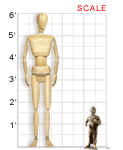VAM galleries including this work:
The Speed Art Museum | Art Through Time || VAM Home
Tang Dynasty (China, 608-907 CE)
GROOM FIGURE, 608-907 CE
Earthenware, pigments; 16-1/2" tall
Gift of Mrs. Mary Steele Tillman, the bequest of Preston Pope Satterwhite, and the bequest of Mrs. Blakemore Wheeler, by exchange, and the gift of Abby and Fairleigh Lussky 2001.16
The Speed Art Museum
Dating back as early as the Warring States period (475-221 BCE), Chinese tomb figures offer us a unique glimpse into the civilization of ancient China. Included in burials to serve the dead, these ceramic sculptures reflect the lifestyle of the deceased and, by extension, the world in which he or she lived.
The well-modeled face, ornate headgear, and painted decoration of this figure suggest that it must have originally graced the tomb of someone of high rank—probably holding the reins of a companion ceramic horse. Although produced in China for use in a Chinese tomb, neither its face nor its hat is Chinese. During the cosmopolitan Tang dynasty, grooms from central Asia and other regions accompanied the horses imported for use by China’s elite. By extension, tomb figures of grooms during the Tang dynasty often depicted foreigners. Despite its non-Chinese elements, the patterning on the figure’s tunic relates directly to Tang Dynasty patterned silks.
About the Artist
During the Tang Dynasty, ceramic production for funerary wares was a major industry overseen by its own government department. Officially, that department established limits, based on social rank, on the number and sizes of grave goods that could accompany the deceased. But those rules were frequently broken. Relatives believed that they could improve their loved one’s status in the afterlife by providing mingqi (tomb figures) over and above what was “needed.”
Tang Dynasty figurative ceramics share particular characteristics. The forms are animated and lifelike; the subject matter covers all aspects of social and ritual life; and the scale of the figures was reasonably small, with the exception of some magnificent larger works commissioned for the tombs of the elite. The variety of forms suggests that the numerous ceramics craftsmen of the time had scope for individual innovation and were not controlled by rules regarding particular styles.
Classroom Ideas
Discussion: What does the title of this piece suggest? What do you think the purpose of the artwork was? What sorts of objects do we surround ourselves with that have particular importance? (Our objects might include awards or plaques celebrating accomplishments, a “lucky” baseball mitt, a crucifix, etc.)
Consider the choice of ceramics as the medium for this work. The artist has chosen a material of the earth (clay) that is vulnerable to cracking or breaking rather than a medium that is more enduring and permanent. How might we have experienced the object differently if it were made of carved stone or wood? How would its effect differ if it were made of cast bronze rather than clay? What factors may have played into the choice of clay as a medium? Availability? Cost? Particular qualities of the material? Compare this piece with the Calyx Krater.
Activities: Draw or sculpt a horse that might accompany this groom figure. Choose a contemporary occupation and sculpt a clay figure showing that occupation.
Links
Read about Chinese ceramics and funeral figures at the National Gallery of Australia.
[www.nga.gov.au/TTTsui/]
Find out more about the Tang Dynasty at the ChinaKnowledge web site.
[www.chinaknowledge.de/History/Tang/tang.html]
Imperial China, an exhibit mounted at the Kentucky Horse Park, explored the horse in Chinese art.
[www.imh.org/imh/china/]

